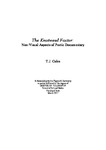The Knotweed Factor: Non-visual Aspects of Poetic Documentary
| dc.contributor.supervisor | Hilton, David | |
| dc.contributor.author | Coles, T.J. | |
| dc.contributor.other | Faculty of Arts, Humanities and Business | en_US |
| dc.date.accessioned | 2017-03-28T15:12:18Z | |
| dc.date.available | 2017-03-28T15:12:18Z | |
| dc.date.issued | 2017 | |
| dc.identifier | 387345 | en_US |
| dc.identifier.uri | http://hdl.handle.net/10026.1/8716 | |
| dc.description.abstract |
This thesis is an inquiry into the creative processes of poetry and poetic expression in documentary. The practice-based element is a 60 minute video about a poet living in Exeter, UK, called James Turner. The documentary is entitled, The Knotweed Factor. This written element of the thesis contextualises the investigation as a discourse on blindness and visual impairment. There are few representations of blindness and/or visual impairment (VI) in The Knotweed Factor. Rather, the documentary is concerned with how visual information (e.g., filming a poet) is translated non-visually (e.g., the sound of the poem being recited). It also addresses the issue of how the non-visual is translated into the visual. I argue in this text that blindness/VI is marginalised in visual studies/culture. This is unfortunate because blindness/VI studies provides valuable context for understanding the dynamics of sound and vision in creative media, which is a central concern of The Knotweed Factor. The rationale for taking this approach is as follows: During the editing, it was noticed that Turner (who is sighted) provides a kind of unprompted audio description (AD) of events in his environment to the audience, as if he is participating in a radio documentary. This raised questions, not only about the ekphrastic possibilities of his technique, but also about the potential to contextualise such scenes as a disquisition on blindness/VI. Blindness/VI is an important and under-theorised element of visual studies/culture (VS/C). Many films, plays, animations, documentaries, and television programmes are audio described. AD enables the blind/visually impaired (also VI) to comprehend and enjoy visual action. It is suggested here that AD theory is an insufficient model for critically reflecting on the creative processes in The Knotweed Factor. This is because the field is presently more concerned with practicability than with aesthetics. It seemed more helpful to address the broader question of how blindness/VI is positioned in VS/C. Doing so has highlighted instances of exclusion and marginalisation in VS/C. In the course of the video production, it was discovered that the interaction of dreams, memories, and ideas (the mindscape) informs the temporal creative process. Most analytical models within VS/C (e.g., Deleuze) offer a dialectical approach to understanding creativity. Henri Bergson, however, proposes a theory of multiplicity, which considers the interplay of phenomenological creativity of the mindscape as a homogenous, multifaceted process, in place of a dialectical one. Martha Blassnigg interrogates Bergson’s responses to audiovisual media and argues that Bergson’s multiplicity formula is more useful for understanding these processes, both for artist and audience. Blassnigg interprets Bergson’s theory as a universality of idea communication. This thesis considers what the universality of audiovisual experience implies for blindness/VI studies. It does so by contextualising the written research as a discourse on VS/C. In The Knotweed Factor, the emotions, sounds, and visual ideas, memories, and dreams which inform James Turner’s creativity are conveyed to the audience in two ways: 1) By sound (Turner’s recitations, interviews, and conversations), and 2) by the documentary’s abstracted audiovisualisations of Turner’s poetry and mindscape. For Turner, the ‘image’ is a personalised, innate phenomenon. It is ephemeral, intangible imagination. Turner’s experience (audiovisualised in The Knotweed Factor) is compared in this written part of the thesis to pre-Socratic ideations of image-making. It is argued that for many cultures, the image was (and for some remains) an emanation of spirit or idea. In other words, the image was considered a transcendent force, and the ‘soul’ of the image eternal and universal. This transcendence is considered in this written element of the thesis as a bridge between the present academic gap in the fields of blindness/VI studies and visual studies/culture. In this text, The Knotweed Factor serves as a case-study to test how non- and minimal-visual elements of audiovisual art and media are positioned in VS/C. Constructed here is a history of the interpretation of blindness and the image, from pre-Socratic aesthetics to the Enlightenment, where ideas concerning the phenomenology of blindness and visual impairment were transformed into epistemological inquiries. This approach enables the researcher to reflect critically on the aesthetics of The Knotweed Factor, using the framework of the non-visual (in this case recited poetry) to test and interrogate the visual (i.e., ‘poetically’ visualised poetry). | en_US |
| dc.language.iso | en | |
| dc.publisher | University of Plymouth | |
| dc.subject | Blindness | en_US |
| dc.subject | Visual Impairment | |
| dc.subject | Cognition | |
| dc.subject | Neuroscience | |
| dc.subject | Imagination | |
| dc.subject | Ekphrasis | |
| dc.subject | Poetics | |
| dc.subject | Documentary | |
| dc.subject.classification | PhD | en_US |
| dc.title | The Knotweed Factor: Non-visual Aspects of Poetic Documentary | en_US |
| dc.type | Thesis | |
| plymouth.version | publishable | en_US |
| dc.identifier.doi | http://dx.doi.org/10.24382/1226 | |
| dc.rights.embargoperiod | No embargo | en_US |
| dc.type.qualification | Doctorate | en_US |
| rioxxterms.version | NA |
Files in this item
This item appears in the following Collection(s)
-
01 Research Theses Main Collection
Research Theses Main


